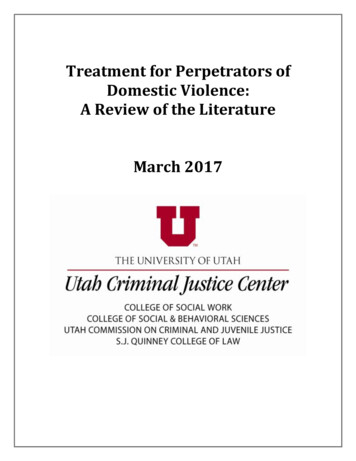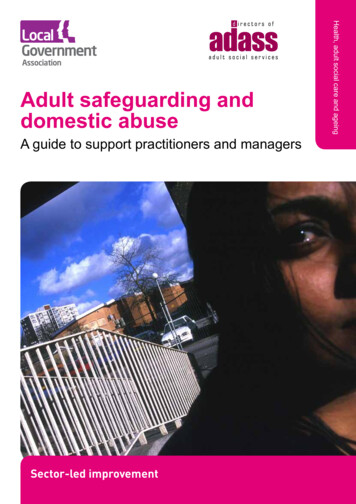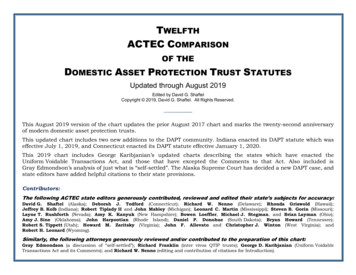
Transcription
Treatment for Perpetrators ofDomestic Violence:A Review of the LiteratureMarch 2017
{THIS PAGE INTENTIONALLY LEFT BLANK}
Treatment for Perpetrators of Domestic Violence:A Review of the LiteratureMarch 2017Jessica L. Seawright, M.S.W.Lauren J. Whitaker, B.S.Brian A. Droubay, M.S.W.Robert P. Butters, Ph.D.Utah Criminal Justice Center, University of Utah
{THIS PAGE INTENTIONALLY LEFT BLANK}
Table of ContentsTable of Contents . iExecutive Summary .iiIntroduction .1Background .2BIP Standards .2National Standards.2Utah Standards .5Efficacy of IPV Perpetrator Treatment .6Primary Modalities .7The Duluth Model .8Cognitive-Behavioral Therapy .9Mixed Interventions . 10Review of Research on Primary Modalities . 10Higher-Quality Research-Primary Modalities . 11Mid- to Lower-Quality Research-Primary Modalities . 14International Research-Primary Modalities . 15Promising Approaches. 17Criminal Justice Techniques . 17Individualized Treatment . 21Other Modalities . 24Conclusion . 29References. 31Appendix A: Extended Search Strategy . 44Appendix B: State/Federal Trends/Comparisons . 47i
Executive SummaryBackgroundThe earliest public response to the issue of domestic violence was in the form of shelters forbattered women and their children. Due to the large number of women returning to their partnersand/or multiple victims from a single perpetrator, shelter workers recognized the need to developprograms to address the behavior of the abuser (Davis & Taylor, 1999; Feder & Wilson, 2005).Feder and Wilson (2005) describe early batterer groups as, “unstructured educational groupsfocused on consciousness-raising and peer self-help within a context of feminist theory” that focuson the role of patriarchy in perpetuating domestic violence (p. 240). Over time, BattererIntervention Programs (BIPs) became more structured and blended with psychoeducationalmodels and cognitive-behavioral therapeutic techniques and skill building exercises. The 1980ssaw significant growth in the number of BIPs nationwide, due to mandatory arrest and mandatoryprosecution policies. Davis and Taylor (1999) describe the policies as requiring that “cases bepursued to conviction regardless of victim desires or willingness to cooperate” (p. 70). Because ofthese policies, the courts experienced an increase in the number of IPV cases and turned to BIPs asan alternative to incarceration (Davis & Taylor, 1999; Feder & Wilson, 2005). In 1984, the AttorneyGeneral’s Task Force on Family Violence recommended mandated treatment for batterers in anattempt to increase treatment compliance (Feder & Wilson, 2005). The Violence Against WomenAct (VAWA) of 1994 (most recently reauthorized in 2013) promotes a continued coordinatedcriminal justice response to domestic violence, which includes mandatory arrest and prosecution ofbatterers. VAWA provides guidelines and technical assistance, incentivized through grant funding,but the responsibility for developing, implementing, and enforcing laws and policies remains instate control (U.S. Department of Justice, 2011).BIP StandardsAccording to Messing and colleagues (2015), all states have strengthened the criminal justiceresponse to domestic violence since the inception of VAWA. In that time, many jurisdictions havedeveloped standards of care for BIPs; however, those standards remain fragmented across states(Gondolf, 1995; Babcock et al., 2004). Nationally there are wide variations in whether states havestandards, and when those standards were last updated. Standards also vary according to thegovernmental units involved and the means of regulation, which might be a local judicial board,another criminal justice body, or a state code agency such as public health, child protection, orhuman services (Maiuro & Eberle, 2008). For the majority of states with standards, the role ofresearch in formulating or revising state standards is unknown and less than a quarter of stateswith standards have documented methods for assuring the quality of treatment programming.State standards often dictate the type, modality, and duration of treatment used to treat IPVperpetrators. Many states ban certain treatment modalities, including interventions for couples andthose that primarily target anger management or substance use disorder. This has resulted in asignificant tension due to the difficulties these bans create with respect to developing andimplementing new treatment modalities (Bennett & Vincent, 2001). Seven states allowed clinicalresearch testing of new modalities of treatment, but definitively banned couples counseling (Milleret al., 2013). In a current review of Utah standards, there were no banned approaches; however,couples therapy cannot be utilized until the IPV perpetrator has completed twelve weeks ofii
treatment and is reassessed. The assessment must determine that “the victim is at low risk forendangerment of further abuse due to counseling” (UDCFS DV Practice Guidelines, 2010, p.11).Nationally, as well as in Utah, a variety of types of organizations facilitate BIP treatment, includingvictim service organizations, family service organizations, and mental health clinics (Davis &Taylor, 1999). As a result, there is significant variety in the facilitation of these groups such asfidelity to a modality, number/duration of sessions, or training and supervision for groupfacilitators. As such, the efficacy of BIPs in both the state of Utah and nationally are not easilyknown.Efficacy of IPV Perpetrator TreatmentThis review examined extant research on the impact of treatment in reducing criminal recidivismamong adult male Interpersonal Violence (IPV) perpetrators (see Appendix A for details on searchmethodology). Findings are presented for the most commonly used treatment modalities (Duluthand CBT – referred to as the primary modalities throughout this report) as well as a number ofpromising approaches. According to Eisikovits & Edelson (1989), the Duluth Model was designed toconfront male perpetrators’ attitudes about women, particularly the normalization of violent andcontrolling behaviors toward women that are conceptualized to result in victimization. Cognitivebehavioral therapy (CBT) is a therapeutic intervention developed by psychologists that seeks tochange specific thoughts and behaviors and improve skills (Dutton, 2007; Murphy & Eckhardt,2005; Babcock & Taillade, 2000) and the application of CBT for IPV was developed as an alternativeto the Duluth model (Murphy & Eckhardt, 2005). Although developed separately, in practice manyBIPs utilize a mixed intervention approach that includes components of both the Duluth model andCBT (Eckhardt et al., 2013; Smedslund et al., 2012; Babcock et al., 2004; Davis & Taylor, 1999).Overall, the findings with respect to effectiveness of the primary modalities (i.e., Duluth and CBT)are modest at best. Of the four higher-quality experimental studies conducted on the primarymodalities, only one showed support for the effectiveness of BIPs. Criticisms of research on IPVtreatments are vast and include limitations of both study design (e.g., varying definitions, accuracyof outcome measures, and a lack of comparison/control group) and intervention (e.g., lack ofuniformity amongst treatment groups, lack of fidelity, exclusion of higher-risk or co-morbid IPVperpetrators).In light of such findings on the efficacy of the primary modalities in reducing recidivism in IPVperpetrators, there are many new treatments being proposed as replacements; however, there isinsufficient research to confidently identify new modalities that would be more effective thanDuluth or CBT. Nevertheless, emerging research does suggest important considerations in thetreatment of these offenders. For instance, reductions in attrition seen with individualizedtreatment (e.g., motivational interviewing, substance use disorder treatment, and separation by riskand/or perpetrator typology) suggest that it should a component in IPV perpetrator treatment;similar to best practice recommendations for general offender treatment (Andrews & Bonta, 2010).Perpetrators of IPV in treatment are most often involved with the criminal justice system. As such,it is vital to have a coordinated response among criminal justice stakeholders, treatment providers,and victim advocates as consequences of a punitive response, namely its impact on victims are stillbeing determined. Best practices for general offenders and other violent perpetrators (e.g., RNR)are promising and should be tested and evaluated with IPV perpetrators specifically. Examples ofwell-designed evaluations are offered throughout the report.iii
Compared to national trends, Utah standards allow for more flexibility with regard to innovationand implementation of modalities outside of the Duluth model and CBT. Specifically, recentrevisions to legislation acknowledge the absence of an evidence-based practice in IPV perpetratortreatment, and promote continued research on what works in IPV perpetrator treatment in light ofthe continued prevalence of IPV in Utah. In addition to piloting promising approaches, programevaluations of individual BIPs, including measures of recidivism and/or the successful acquisitionof skills targeted by the BIPs, are recommended to ensure accountability amongst treatmentproviders across the state.iv
IntroductionThis review serves as a tool to understand effective treatments for reducing the recidivism ofInterpersonal Violence (IPV) perpetrators commonly called batterer intervention programs (BIPs).Results are presented in two parts: 1) a review of state and federal laws in relation to research onBIPs and 2) a synthesis of research on the effectiveness of BIP interventions, including primarymodalities and promising approaches.The review considers studies published in peer-reviewed journals in the fields of medical and socialscience. Studies must have been published in English in the United States after 1990. The reviewonly includes studies that examined adult males (over 18 years of age) who have been charged orconvicted of at least one domestic violence offense against a female adult (over 18 years of age)partner or former partner (whether or not they are/were married or cohabiting at the time) andsubsequently mandated to treatment.The review prioritizes treatment methods and modalities that have the most research completed todate. This includes group treatment in the form of a feminist-psychoeducational (e.g., Duluthmodel) or cognitive-behavioral approach. The review is also focused on recidivism as an outcome,defined as new criminal justice contact (i.e., arrest, conviction, incarceration) for any crimeincluding domestic violence. In order to situate the discussion within the complexities of bothtreating batterers and subsequently studying those impacts, variations in outcome reporting will beexplored and discussed. For example, there are three primary methods for tracking offenderrecidivism: self-report, official report, and victim report. Due to the likelihood that batterersunderreport, studies that used self-reported recidivism as an outcome are not included (Palmer,1991). Studies that used official records are included, with the caveat that underreporting is stilllikely. Dutton et al. (1997) reported that the proportion of arrest to victim-reported abuse was onein 35; that is, for every reported arrest, there were 35 assaultive actions. Victim report iscomplicated by the difficulty in maintaining contact with victims as well as the possibility that theperpetrator has a new partner after treatment (Bennett & Williams, 2001). This review includesstudies that defined recidivism by victim report and/or official record. A thorough review yield atotal of 95 articles, including: 28 studies on the efficacy of the primary modalities; five studies oncoordinated criminal justice responses; 40 studies on promising practices; 14 meta-analyses,systematic reviews, literature reviews and book chapters; and eight references that inform thediscussion of state and federal legislation and standards for the treatment of IPV perpetrators.For complete detail, including search terms and databases searched, see Appendix A.1
BackgroundThe earliest public response to the issue of domestic violence was in the form of shelters forbattered women and their children. Due to the large number of women returning to their partnersand/or multiple victims from a single perpetrator, shelter workers recognized the need to developprograms to address the behavior of the abuser (Davis & Taylor, 1999; Feder & Wilson, 2005).Feder and Wilson (2005) describe early batterer groups as, “unstructured educational groupsfocused on consciousness-raising and peer self-help within a context of feminist theory” that focuson the role of patriarchy in perpetuating domestic violence (p. 240). Over time, BIPs became morestructured and blended with psychoeducational models and cognitive-behavioral therapeutictechniques and skill building exercises. The first structured BIPs were EMERGE, in Boston, and theDomestic Abuse Intervention Project, or the Duluth Model, in Duluth, Minnesota (Messing et al.,2015).The 1980s saw significant growth in the number of BIPs nationwide, due to mandatory arrest andmandatory prosecution policies. Davis and Taylor (1999) describe the policies as requiring that“cases be pursued to conviction regardless of victim desires or willingness to cooperate” (p. 70).Because of these policies, the courts experienced an increase in the number of IPV cases and turnedto BIPs as an alternative to incarceration (Davis & Taylor, 1999; Feder & Wilson, 2005).In 1984, the Attorney General’s Task Force on Family Violence recommended mandated treatmentfor batterers (Feder & Wilson, 2005). Mandating treatment was an early attempt to increasecompliance within this offender population with high rates of attrition from treatment. Currently, amajority of BIP participants are court-mandated to complete treatment (Messing, 2015). At thestate level, batterers may be mandated to treatment through a variety of approaches: pre-trialdiversion, as a condition of their sentence, a requirement of probation, or by entering a plea inabeyance (Davis & Taylor, 1999).The Violence Against Women Act (VAWA) of 1994 (most recently reauthorized in 2013) promotes acontinued coordinated criminal justice response to domestic violence, which includes mandatoryarrest and prosecution of batterers. VAWA provides guidelines and technical assistance,incentivized through grant funding, but the responsibility for developing, implementing, andenforcing laws and policies remains in state control (U.S. Department of Justice, 2011). According toMessing and colleagues (2015), all states have strengthened the criminal justice response todomestic violence since the inception of VAWA. In that time, many jurisdictions have developedstandards of care for BIPs; however, those standards remain fragmented across states (Gondolf,1995; Babcock et al., 2004).BIP StandardsNational StandardsPrimary mechanisms for states to implement required standards include certification requirementsfor providers and tying funding to compliance (Stover & Lent, 2014; Saunders, 2008). While statesare continuously updating standards, this review will utilize the compiled state standards from areview conducted by Miller and colleagues (2013) to characterize the range of standards across theUnited States. Nationally there are wide variations in whether states have standards, and whenthose standards were last updated. As shown in Figure 1, as of 2013, seven states had not2
developed standards and seven states, including Utah, had updated standards within the last fiveyears.Figure 1: Updated Standards-IPV Perpetrator Treatment5 years7Last updated15 years3320 years4No Standards705101520253035Number of StatesAccording to Maiuro and Eberle (2008), standards vary according to the governmental unitsinvolved and the means of regulation, which might be a local judicial board (CO), another criminaljustice body (IA), or a state code agency such as public health (MA), child protection (WA), orhuman services (IL). Twenty-seven states, including Utah, had required standards 1. An example of arequired standard is one that requires programs to adhere to standards for licensing or funding.Sixteen states (not including Utah) had mandated BIPs. An example of a mandated BIP is when astate requires that all IPV perpetrators attend a BIP for treatment.For the majority of states with standards, the role of research in formulating or revising statestandards is unknown. There are even fewer states that have documented where the responsibilityof updating standards resides and less than a quarter of states with standards that documentmethods for assuring the quality of treatment programming. Figure 2 shows the role of research instate standards for IPV perpetrator treatment. Of the 44 states with documented standards, nine(IA, IL, CO, ID, PA, VT, NH, HI, AZ) explicitly referenced some body of research that was consulted indrafting the standards. Only two states (IA, NH) described an infrastructure for determining andupdating standards such as a steering committee that monitors research findings and conductspilot projects to make appropriate decisions. Ten states described efforts at quality assurance in thedevelopment of BIP treatment standards (ID, IL, MA, MN, ND, NH, OH, VA, VT, WV). Qualityassurance refers to an explicit mechanism that encourages governing bodies to use research and/orevaluation to develop standards, including: pilot projects, collection of data recommended,mandated implementation studies, program evaluation or outcomes studies.1In 2015, Williston noted that 45 states had mandated batterer intervention standards.3
Figure 2: The Role of Research in State Standards for IPV Perpetrator Treatment504540291035302520154235341050Consulted ResearchInfrastructure to updatestandardsQuality Assurance inStandardsInclude9210Does Not Include354234State standards dictate a variety of aspects including the type of treatment used to treat IPVperpetrators. The preferred modality of treatment is often dictated by state standards. The majorityof states with standards promote the use of the Duluth Model. A Cognitive-Behavioral approach isthe second most preferred modality. Utah allows programs to choose the modality utilized intreatment. However, in reviewing materials utilized for training Utah healthcare providers and aseparate training from the Utah Domestic Violence Coalition, both utilized standard Duluthresources and CBT techniques (UDVC Training Presentation, 2013; DHS Provider Manual, 2014).This highlights the prevalence of a mixed Duluth and CBT approach in the state of Utah. As theprimary modalities covered in the available research on treatment for IPV perpetrators, thesemodalities are discussed in depth below.Many states ban certain treatment modalities, including interventions for couples and those thatprimarily target anger management or substance use disorder. This has resulted in a significanttension due to the difficulties these bans create with respect to developing and implementing newtreatment modalities (Bennett & Vincent, 2001). Seven states (CO, HI, ID, MI, OR, RI, TX) allowedclinical research testing of new modalities of treatment, but definitively banned couples counseling(Miller et al., 2013). One state (IA) encouraged standards that safely test innovative interventionsand did not ban couples therapy. In a current review of Utah standards, there were no bannedapproaches; however, couples therapy cannot be utilized until the IPV perpetrator has completedtwelve weeks of treatment and is reassessed. The assessment must determine that “the victim is atlow risk for endangerment of further abuse due to counseling” (UDCFS DV Practice Guidelines,2010, p.11).State standards also often dictate length of treatment and how the treatment should be delivered.The shortest length required is four hours (MT) and the longest is a minimum of 52 weeks (OK, MA,NM, CA, ID, WA, NH) (Miller et al., 2013). The national average for mandated treatment length is 1626 weeks and Utah minimum treatment length standards are in-line with the national average (i.e.,4
16-24 weeks). Thirty-eight states specifically recommend group treatment, 26 recommend genderspecific treatment and 25 promote a gender-specific group treatment (i.e., men’s group treatment).For additional tables of the state standards adapted from Miller et al., 2013 see Appendix B.Utah StandardsUtah adopted standards in 1996 and most recently updated legislation that impacted state IPVstandards in 2016. Updated legislation included the removal of the treatment mandate, which waschanged to a provision that the court should order treatment as determined necessary. Utahlegislation promotes coordination between the criminal justice system and treatment providers, inthe form of pro-arrest policies and court-based monitoring of treatment compliance.The Utah Division of Children and Family Services (DCFS) is responsible for administering domesticviolence services, including IPV perpetrator treatment services. The division’s goal is “to ensure theavailability of treatment programs for court-ordered and voluntarily participating perpetrators toteach them non-violent behavior patterns” (Utah’s Division of Child and Family Services DomesticViolence Practice Guidelines, 2010). The guidelines require that programs: Hold perpetrators of domestic violence, not their victims, responsible and accountable fortheir abusive behaviorIncrease the safety of the adult victim as a strategy for increasing the safety and well-beingof the childrenRespect the rights of adult victims to direct their own livesFacilitate community collaborationBe offered to all persons meeting the definition of co-habitant who either voluntarily orthrough a court order seek domestic violence services regardless of whether they havechildrenFunding for treatment is a point of tension both locally and nationally. Victim services organizationsare concerned that funding to batterer treatment reduces the amount of funding available tosupport victims. In a 2014 General Session issue brief, DCFS defended public funding of batterertreatment to the Social Services Appropriation Subcommittee:DCFS uses some of its funding to provide intervention for perpetrators which some havequestioned. DCFS defends the practice stating, among other reasons that it ‘pays fortreatment of perpetrators because it is essential to keep children safe, strengthen families,and provide quality domestic violence services. Research tells us that preventing domesticviolence requires a multi-systemic approach that includes supporting the needs of all familymembers with a coordinated community response’ (Office of Legislative Fiscal Analyst,2014).For all outpatient treatment providers, the Department of Human Services Office of Licensing hasrequirements for treatment, which include compliance measure with Utah State Core Rules, (R501),the Outpatient Treatment Program Rules (R501-21), and the Direct Service portion (R501-21-6-D)(UDVC presentation). Additionally, there are specialized training requirements for providers. Thereare approximately 20 providers that are listed as contract providers with DCFS. A contract providerhas “prior authorization from the regional DCFS DV specialist and further allows DCFS to subsidize5
the cost of the offender evaluation and intervention services” (Department of Human ServicesLicensing Division, 2014).Due to county size, and subsequent shortage of providers, 12 counties (i.e., Beaver, Box Elder,Emery, Garfield, Grand, Juab, Kane, Morgan, Piute, Rich, San Juan, and Wayne) must refer IPVperpetrators directly to their regional office Division of Child & Family Services (DCFS) in order todetermine a BIP provider. There are providers outside of DCFS in 15 counties in Utah (i.e., Cache,Carbon, Davis, Duchesne, Iron, Salt Lake, San Pete, Sevier, Summit, Tooele, Uintah, Utah, Wasatch,Washington, Weber). Within these counties, there are approximately 65 unique domestic violenceabuse providers (UDVC, 2013; DHS, 2014) with at least 11 of those providers having multiple sitesavailable for treatment.Nationally, as well as in Utah, a variety of types of organizations facilitate BIP treatment, includingvictim service organizations, family service organizations, and mental health clinics (Davis &Taylor, 1999). As a result, there is significant variety in the facilitation of these groups such asfidelity to a modality, number/duration of sessions, or training and supervision for groupfacilitators. As such, the efficacy of BIPs in both the state of Utah and nationally are not easilyknown.While treatment standards across the nation are in flux, Utah standards allow for more flexibilitywhen compared with other states with regard to innovation and implementation of modalitiesoutside of the Duluth model and CBT groups for men. Specifically, recent revisions to legislationacknowledge the absence of an evidence-based practice in IPV perpetrator treatment, and promotecontinued research on what works in IPV perpetrator treatment in light of the continuedprevalence of IPV in Utah.Efficacy of IPV Perpetrator TreatmentReferral of an IPV perpetrator to a BIP is one of the strongest predictors that a woman will leaveshelter and return to the perpetrator (Bennett & Williams, 2001). As such, the prevalence of IPVperpetration in Utah underscores the importance of understanding BIP efficacy. According to theUtah Department of Health’s Violence and Injury Prevention Program (VIPP, 2010a), women inUtah experience approximately 170,000 partner-related physical assaults and rapes each year.Further, when asked if they had ever been physically assaulted, 14.2% of women (18 years andolder) reported being assaulted. There is approximately one DV-related homicide each month inUtah, with the majority of those homicides committed by male offenders against a female victim(VIPP, 2010b).Clearly, the consequences of ineffective treatment are high. There were approximately 2,500 BIPsin the United States as of 2007 (Saunders, 2008) and courts continue to mandate treatment tohundreds of thousands of convicted offenders (Mills et al., 2013), suggesting a public confidence inthe effectiveness of treatment (Bennett & Williams, 2001, p.14). Overall, the available research isnot clear with respect to the efficacy of BIPs, which means some questions remain regarding theallocation of resources and whether or not they result in a positive and significant impact onindividuals, families, and communities.Historically, there has been much published on treatment of IPV perpetrators. In 1989, more thanfifty published works that described or evaluated treatment groups for men
couples therapy cannot be utilized until the IPV perpetrator has completed twelve weeks of . iii . Cognitive-behavioral therapy (CBT) is a therapeutic intervention developed by psychologists that seeks to change specific thoughts and b










